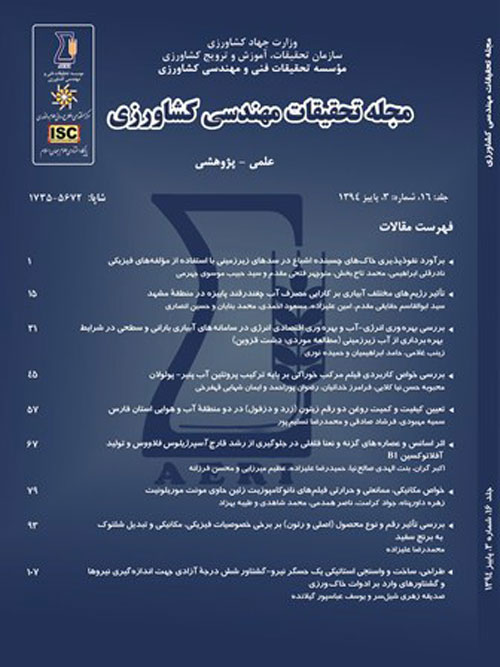Improving Irrigation Management for Hybrid Maize Seeds in Kerman Province Using a SWAP Model
Author(s):
Abstract:
This research was carried out on corn in the Orzuiyeh region of Kerman province over twoconsecutive seasons (2005-6 to 2007-8). The experiment was done as a split plot with acompletely randomized block design and four replications. Four levels of consumed water(60%, 80%, 100% water requirement, water use based on regional custom) and three varieties (404SC, 700SC, 704SC) were the main factors and the sub-plots, respectively. The measured parameters included irrigation water volume, grain yield, and leaf area index. The results of the SWAP model indicated that a relatively good correlation existed between observation and calculated data, with irrigation treatment values being close to potential evapotranspiration.There were also significant differences between observation and calculated data for thevarieties. These differences were observed in values obtained for grain yield and leaf areaindex. In conclusion, the corn variety 704SC was more suitable than the other varieties forOrzuiyeh region. Considering the salinity of the water available for irrigation (EC = 4 dS/m2) in the region, 1100 mm per m2 of water was required to produce the highest relative grain yield. The results also showed a 7% decline in crop production for every increase of 2 dS/m2 in salinity.
Keywords:
Language:
Persian
Published:
Journal of Agricultural Engineering Research, Volume:12 Issue: 1, 2011
Page:
17
https://magiran.com/p884121
مقالات دیگری از این نویسنده (گان)
-
Determination of Alfalfa Water Productivity in Different Regions of Iran
Mehdi Akbari *, Fariborz Abbasi, Abolfazl Nasseri, Afshin Gomrokchi, Mostafa Goodarzi, Amir Eslami, Masoud Farzamnia, R Alimohammadi, , Reza Bahramloo, Ali Ghadami Firouzabadi, Seyed Abolghassem Haghayeghi Moghaddam, Ardalan Zolfagharan, Jamal Ahmadaali, Mohamad Abasi, Hamid Riahi, Mohammad Mehdi Nakhjavanimoghaddam
Journal of Water Research in Agriculture, -
An Investigation of the Yield and Water Productivity of Fodder Corn under the Combined Effect of Different Irrigation Levels and the Depth of Drip Line
Nader Koohi Chellehkaran *, Hamid Najafi Nejad, Elahe Kanani
Iranian Journal of Irrigation & Drainage,



